Tri-Mation Industries – Custom Automated Assembly Machine Expertise
5 Innovative Microrobotics Applications
Science Magazine robot videos 2022 (+ breakthrough of the year)
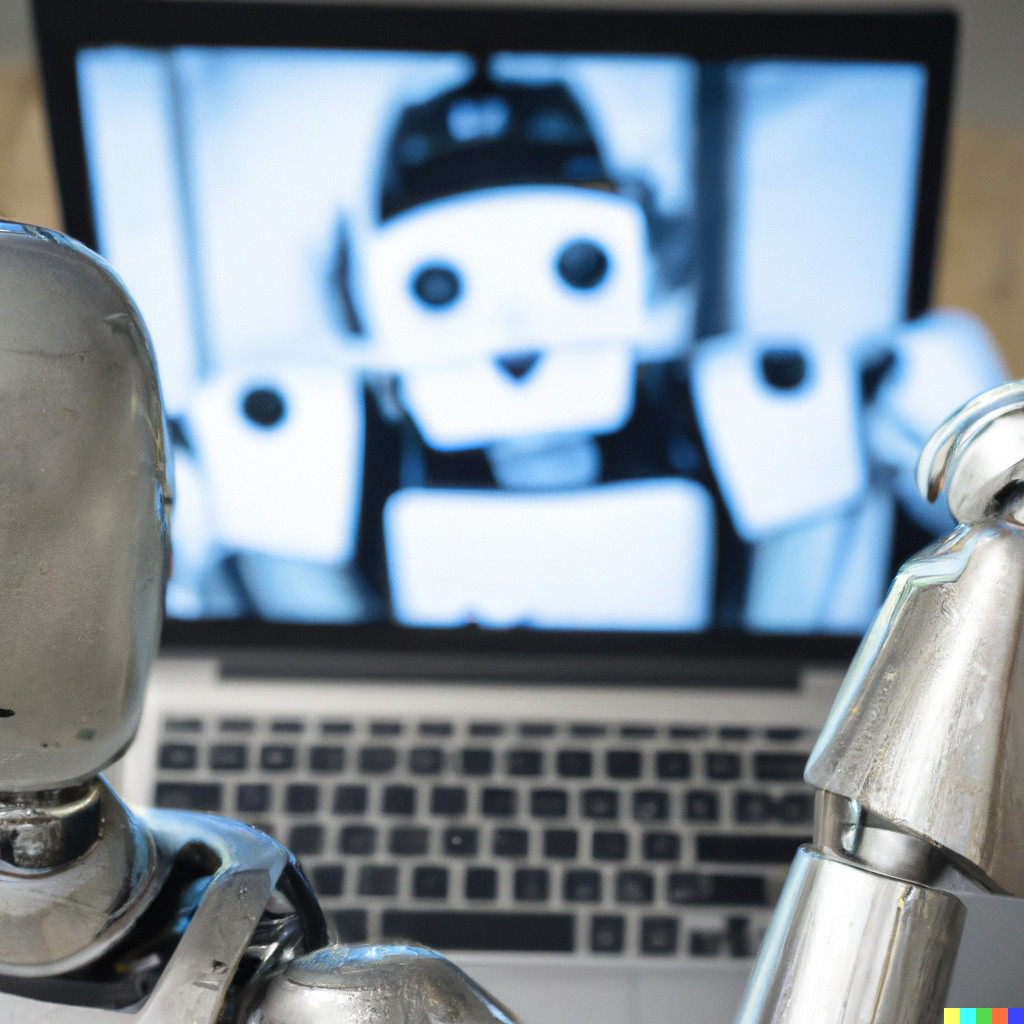
Image generated by DALLE 2 using prompt “a hyperrealistic image of a robot watching robot videos on a laptop”
Did you manage to watch all the holiday robot videos of 2022? If you did but are still hungry for more, I have a few more videos from Science Magazine featuring robotics research that were released during last year. Enjoy!
Extra: breakthrough of the year
2022 Top Article – What Is Multipath Interference? How to Minimize It in Time-of-flight Cameras?
Five ways drones will change the way buildings are designed
By Paul Cureton (Senior Lecturer in Design (People, Places, Products), Lancaster University) and Ole B. Jensen (Professor of Urban Theory and Urban Design, Aalborg University)
Drones are already shaping the face of our cities – used for building planning, heritage, construction and safety enhancement. But, as studies by the UK’s Department of Transport have found, swathes of the public have a limited understanding of how drones might be practically applied.
It’s crucial that the ways drones are affecting our future are understood by the majority of people. As experts in design futures and mobility, we hope this short overview of five ways drones will affect building design offers some knowledge of how things are likely to change.
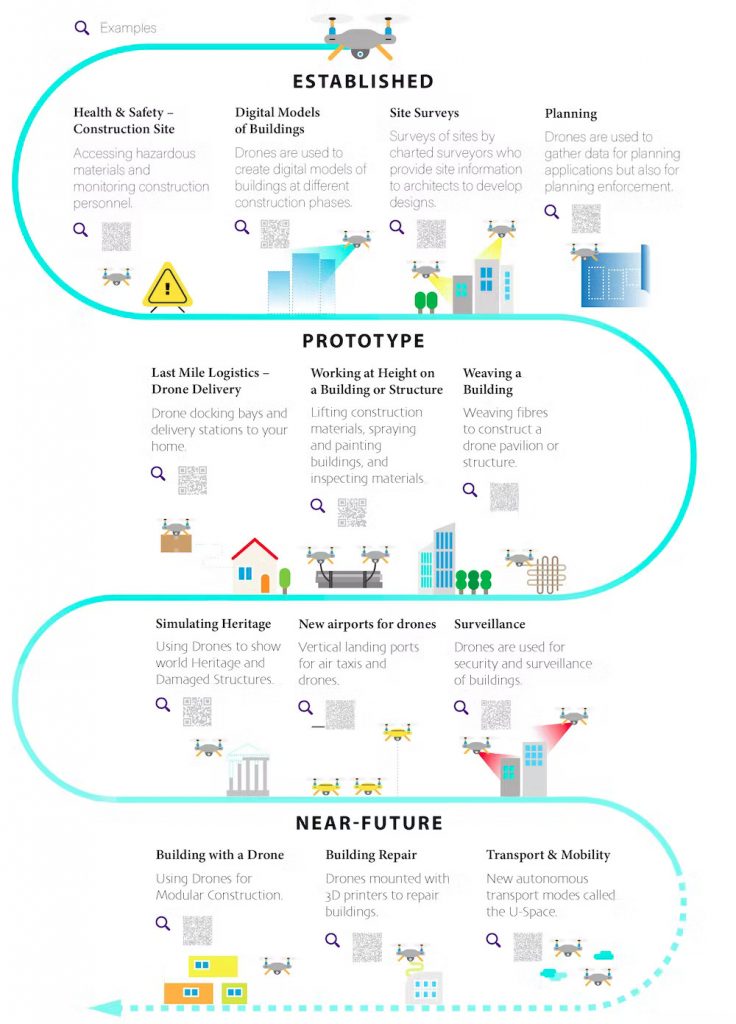
Infographic showcasing other ways drones will influence future building design. Nuri Kwon, Drone Near-Futures, Imagination Lancaster, Author provided
1. Creating digital models of buildings
Drones can take photographs of buildings, which are then used to build 3D models of buildings in computer-aided design software.
These models have accuracy to within a centimetre, and can be combined with other data, such as 3D scans of interiors using drones or laser scanners, in order to provide a completely accurate picture of the structure for surveyors, architects and clients.
Using these digital models saves time and money in the construction process by providing a single source thaOle B. Jensent architects and planners can view.
2. Heritage simulations
Studio Drift are a multidisciplinary team of Dutch artists who have used drones to construct images through theatrical outdoor drone performances at damaged national heritage sites such as the Notre Dame in Paris, Colosseum in Rome and Gaudí’s Sagrada Familia in Barcelona.
Drones could be used in the near-future in a similar way to help planners to visualise the final impact of restoration or construction work on a damaged or partially finished building.
3. Drone delivery
The arrival of drone delivery services will see significant changes to buildings in our communities, which will need to provide for docking stations at community hubs, shops and pick-up points.
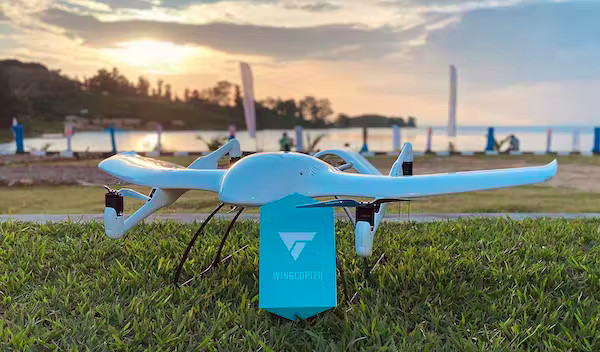
Wingcopter are one of many companies trialling delivery drones. Akash 1997, CC BY-SA
There are likely to be landing pads installed on the roofs of residential homes and dedicated drone-delivery hubs. Research has shown that drones can help with the last mile of any delivery in the UK, Germany, France and Italy.
Architects of the future will need to add these facilities into their building designs.
4. Drones mounted with 3D printers
Two research projects from architecture, design, planning, and consulting firm Gensler and another from a consortium led by Imperial College London (comprising University College London, University of Bath, University of Pennsylvania, Queen Mary University of London, and Technical University of Munich) named Empa have been experimenting with drones with mounted 3D printers. These drones would work at speed to construct emergency shelters or repair buildings at significant heights, without the need for scaffolding, or in difficult to reach locations, providing safety benefits.
Gensler have already used drones for wind turbine repair and researchers at Imperial College are exploring bee-like drone swarms that work together to construct blueprints. The drones coordinate with each other to follow a pre-defined path in a project called Aerial Additive Manufacturing. For now, the work is merely a demonstration of the technology, and not working on a specific building.
In the future, drones with mounted 3D printers could help create highly customised buildings at speed, but how this could change the workforce and the potential consequences for manual labour jobs is yet to be understood.
5. Agile surveillance
Drones offer new possibilities for surveillance away from the static, fixed nature of current systems such as closed circuit television.
Drones with cameras and sensors relying on complex software systems such as biometric indicators and “face recognition” will probably be the next level of surveillance applied by governments and police forces, as well as providing security monitoring for homeowners. Drones would likely be fitted with monitoring devices, which could communicate with security or police forces.
Drones used in this way could help our buildings become more responsive to intrusions, and adaptable to changing climates. Drones may move parts of the building such as shade-creating devices, following the path of the sun to stop buildings overheating, for example.![]()
This article is republished from The Conversation under a Creative Commons license. Read the original article.
Robot Talk Podcast – November & December episodes (+ bonus winter treats)

Episode 24 – Gopal Ramchurn
Claire chatted to Gopal Ramchurn from the University of Southampton about artificial intelligence, autonomous systems and renewable energy.
Sarvapali (Gopal) Ramchurn is a Professor of Artificial Intelligence, Turing Fellow, and Fellow of the Institution of Engineering and Technology. He is the Director of the UKRI Trustworthy Autonomous Systems hub and Co-Director of the Shell-Southampton Centre for Maritime Futures. He is also a Co-CEO of Empati Ltd, an AI startup working on decentralised green hydrogen technologies. His research is about the design of Responsible Artificial Intelligence for socio-technical applications including energy systems and disaster management.
Episode 25 – Ferdinando Rodriguez y Baena
Claire chatted to Ferdinando Rodriguez y Baena from Imperial College London about medical robotics, robotic surgery, and translational research.
Ferdinando Rodriguez y Baena is Professor of Medical Robotics in the Department of Mechanical Engineering at Imperial College, where he leads the Mechatronics in Medicine Laboratory and the Applied Mechanics Division. He has been the Engineering Co-Director of the Hamlyn Centre, which is part of the Institute of Global Health Innovation, since July 2020. He is a founding member and great advocate of the Imperial College Robotics Forum, now the first point of contact for roboticists at Imperial College.
Episode 26 – Séverin Lemaignan
Claire chatted to Séverin Lemaignan from PAL Robotics all about social robots, behaviour, and robot-assisted human-human interactions.
Séverin Lemaignan is Senior Scientist at Barcelona-based PAL Robotics. He leads the Social Intelligence team, in charge of designing and developing the socio-cognitive capabilities of robots like PAL TIAGo and PAL ARI. He obtained his PhD in Cognitive Robotics in 2012 from the CNRS/LAAS and the Technical University of Munich, and worked at Bristol Robotics Lab as Associate Professor in Social Robotics, before moving to industry. His research primarily concerns socio-cognitive human-robot interaction, child-robot interaction and human-in-the-loop machine learning for social robots.
Episode 27 – Simon Wanstall
Claire chatted to Simon Wanstall from the Edinburgh Centre for Robotics all about soft robotics, robotic prostheses, and taking inspiration from nature.
Simon Wanstall is a PhD student at the Edinburgh Centre for Robotics, working on advancements in soft robotic prosthetics. His research interests include soft robotics, bioinspired design and healthcare devices. Simon’s current project is to develop soft sensors so that robotic prostheses can feel the world around them. In order to develop his skills in this area, Simon is also undertaking an industrial placement with Touchlab, a robotics company specialising in sensors.
Episode 28 – Amanda Prorok
Claire chatted to Amanda Prorok from the University of Cambridge all about self-driving cars, industrial robots, and multi-robot systems.
Amanda Prorok is Professor of Collective Intelligence and Robotics in the Department of Computer Science and Technology at Cambridge University, and a Fellow of Pembroke College. She is interested in finding practical methods for hard coordination problems that arise in multi-robot and multi-agent systems.
Episode 29 – Sina Sareh
Claire chatted to Sina Sareh from the Royal College of Art all about industrial inspection, soft robotics, and robotic grippers.
Sina Sareh is the Academic Leader in Robotics at Royal College of Art. He is currently a Reader (Associate Professor) in Robotics and Design Intelligence at RCA, and a Fellow of EPSRC, whose research develops technological solutions to problems of human safety, access and performance involved in a range of industrial operations. Dr Sareh holds a PhD from the University of Bristol, 2012, and served as an impact assessor of Sub-panel 12: Engineering in the assessment phase of the Research Excellence Framework (REF) 2021.
Episode 30 – Ana Cavalcanti
Claire chatted to Ana Cavalcanti from the University of York all about software development, testing and verification, and autonomous mobile robots.
Ana Cavalcanti is a Royal Academy of Engineering Chair in Emerging Technologies. She is the leader of the RoboStar centre of excellence on Software Engineering for Robotics. The RoboStar approach to model-based Software Engineering complements current practice of design and verification of robotic systems, covering simulation, testing, and proof. It is practical, supported by tools, and yet mathematically rigorous.
Bonus winter treats
What is your favourite fictional robot?
What is your advice for a robotics career?
What is your favourite machine or tool?
Could you be friends with a robot?
A day in the life
2022 Top Article – World’s Largest Pasta Production Plant a Showcase for Integrated Robotics and Sustainable Distribution
In search for the intelligent machine
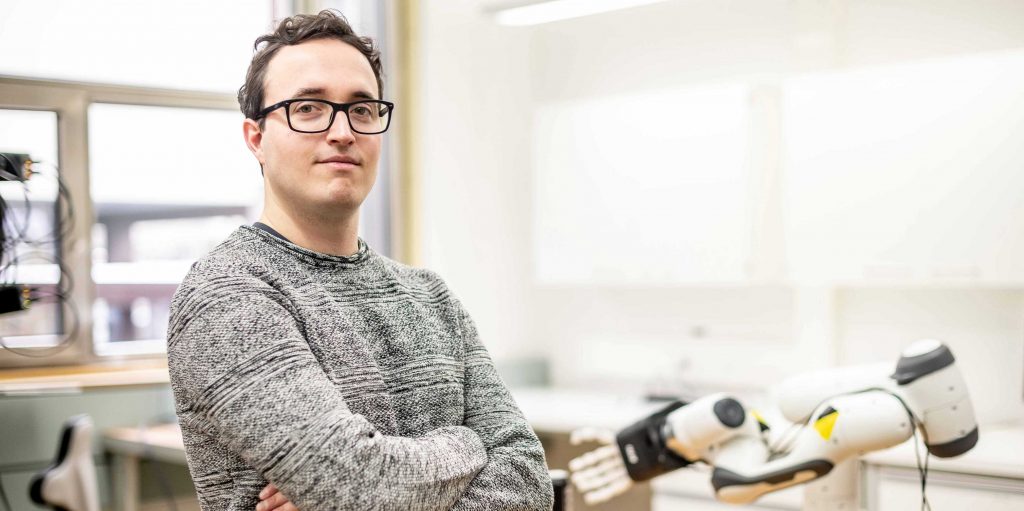
Elvis Nava is a fellow at ETH’ Zurich’s AI center as well as a doctoral student at the Institute of Neuroinformatics and in the Soft Robotics Lab. (Photograph: Daniel Winkler / ETH Zurich)
By Christoph Elhardt
In ETH Zurich’s Soft Robotics Lab, a white robot hand reaches for a beer can, lifts it up and moves it to a glass at the other end of the table. There, the hand carefully tilts the can to the right and pours the sparkling, gold-coloured liquid into the glass without spilling it. Cheers!
Computer scientist Elvis Nava is the person controlling the robot hand developed by ETH start-up Faive Robotics. The 26-year-old doctoral student’s own hand hovers over a surface equipped with sensors and a camera. The robot hand follows Nava’s hand movement. When he spreads his fingers, the robot does the same. And when he points at something, the robot hand follows suit.
But for Nava, this is only the beginning: “We hope that in future, the robot will be able to do something without our having to explain exactly how,” he says. He wants to teach machines to carry out written and oral commands. His goal is to make them so intelligent that they can quickly acquire new abilities, understand people and help them with different tasks.
Functions that currently require specific instructions from programmers will then be controlled by simple commands such as “pour me a beer” or “hand me the apple”. To achieve this goal, Nava received a doctoral fellowship from ETH Zurich’s AI Center in 2021: this program promotes talents that bridges different research disciplines to develop new AI applications. In addition, the Italian – who grew up in Bergamo – is doing his doctorate at Benjamin Grewe’s professorship of neuroinformatics and in Robert Katzschmann’s lab for soft robotics.
Developed by the ETH start-up Faive Robotics, the robot hand imitates the movements of a human hand. (Video: Faive Robotics)
Combining sensory stimuli
But how do you get a machine to carry out commands? What does this combination of artificial intelligence and robotics look like? To answer these questions, it is crucial to understand the human brain.
We perceive our environment by combining different sensory stimuli. Usually, our brain effortlessly integrates images, sounds, smells, tastes and haptic stimuli into a coherent overall impression. This ability enables us to quickly adapt to new situations. We intuitively know how to apply acquired knowledge to unfamiliar tasks.
“Computers and robots often lack this ability,” Nava says. Thanks to machine learning, computer programs today may write texts, have conversations or paint pictures, and robots may move quickly and independently through difficult terrain, but the underlying learning algorithms are usually based on only one data source. They are – to use a computer science term – not multimodal.
For Nava, this is precisely what stands in the way of more intelligent robots: “Algorithms are often trained for just one set of functions, using large data sets that are available online. While this enables language processing models to use the word ‘cat’ in a grammatically correct way, they don’t know what a cat looks like. And robots can move effectively but usually lack the capacity for speech and image recognition.”
“Every couple of years, our discipline changes the way we think about what it means to be a researcher,” Elvis Nava says. (Video: ETH AI Center)
Robots have to go to preschool
This is why Nava is developing learning algorithms for robots that teach them exactly that: to combine information from different sources. “When I tell a robot arm to ‘hand me the apple on the table,’ it has to connect the word ‘apple’ to the visual features of an apple. What’s more, it has to recognise the apple on the table and know how to grab it.”
But how does the Nava teach the robot arm to do all that? In simple terms, he sends it to a two-stage training camp. First, the robot acquires general abilities such as speech and image recognition as well as simple hand movements in a kind of preschool.
Open-source models that have been trained using giant text, image and video data sets are already available for these abilities. Researchers feed, say, an image recognition algorithm with thousands of images labelled ‘dog’ or ‘cat.’ Then, the algorithm learns independently what features – in this case pixel structures – constitute an image of a cat or a dog.
A new learning algorithm for robots
Nava’s job is to combine the best available models into a learning algorithm, which has to translate different data, images, texts or spatial information into a uniform command language for the robot arm. “In the model, the same vector represents both the word ‘beer’ and images labelled ‘beer’,” Nava says. That way, the robot knows what to reach for when it receives the command “pour me a beer”.
Researchers who deal with artificial intelligence on a deeper level have known for a while that integrating different data sources and models holds a lot of promise. However, the corresponding models have only recently become available and publicly accessible. What’s more, there is now enough computing power to get them up and running in tandem as well.
When Nava talks about these things, they sound simple and intuitive. But that’s deceptive: “You have to know the newest models really well, but that’s not enough; sometimes getting them up and running in tandem is an art rather than a science,” he says. It’s tricky problems like these that especially interest Nava. He can work on them for hours, continuously trying out new solutions.

Nava spends the majority of his time coding. (Photograph: Elvis Nava)
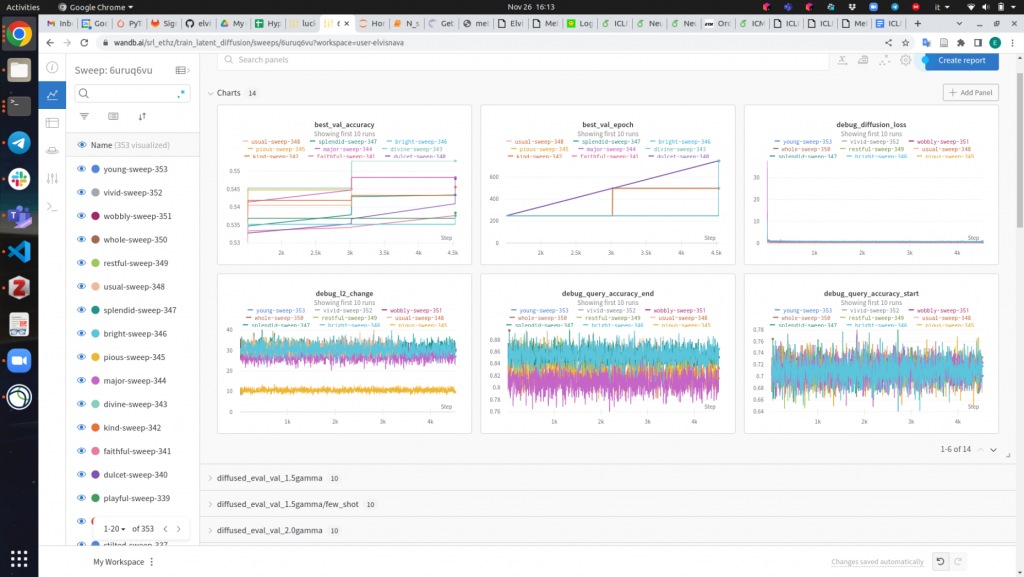
Nava evaluates his learning algorithm. The results of the experiment in a nutshell. (Photograph: Elvis Nava)
Special training: Imitating humans
Once the robot arm has completed preschool and has learnt to understand speech, recognise images and carry out simple movements, Nava sends it to special training. There, the machine learns to, say, imitate the movements of a human hand when pouring a glass of beer. “As this involves very specific sequences of movements, existing models no longer suffice,” Nava says.
Instead, he shows his learning algorithm a video of a hand pouring a glass of beer. Based on just a few examples, the robot then tries to imitate these movements, drawing on what it has learnt in preschool. Without prior knowledge, it simply wouldn’t be able to imitate such a complex sequence of movements.
“If the robot manages to pour the beer without spilling, we tell it ‘well done’ and it memorises the sequence of movements,” Nava says. This method is known as reinforcement learning in technical jargon.
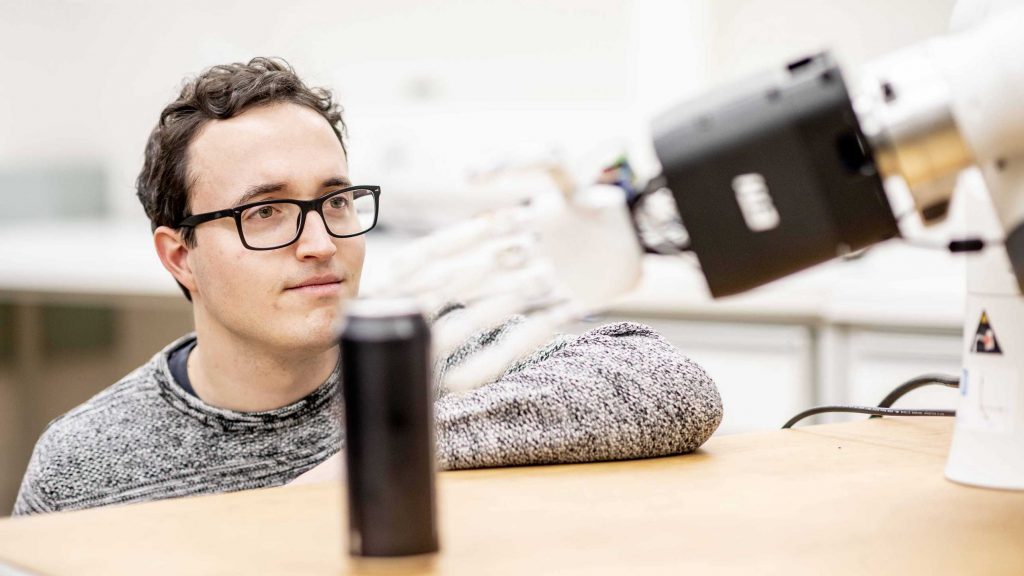
Elvis Nava teaches robots to carry out oral commands such as “pour me a beer”. (Photograph: Daniel Winkler / ETH Zürich)
Foundations for robotic helpers
With this two-stage learning strategy, Nava hopes to get a little closer to realising the dream of creating an intelligent machine. How far it will take him, he does not yet know. “It’s unclear whether this approach will enable robots to carry out tasks we haven’t shown them before.”
It is much more probable that we will see robotic helpers that carry out oral commands and fulfil tasks they are already familiar with or that closely resemble them. Nava avoids making predictions as to how long it will take before these applications can be used in areas such as the care sector or construction.
Developments in the field of artificial intelligence are too fast and unpredictable. In fact, Nava would be quite happy if the robot would just hand him the beer he will politely request after his dissertation defence.
2022 Top Article – Wireless Charging Enables Industry 4.0 Implementation with Mobile Robots
Holiday robot videos 2022 updated (+ how robots prepare an Amazon warehouse for Christmas)

Image generated by OpenAI’s DALL-E 2 with prompt “a robot surrounded by humans, Santa Claus and a Christmas tree at Christmas, digital art”.
Happy holidays everyone! And many thanks to all those that sent us their holiday videos. Here are some robot videos of this year to get you into the spirit of the season. We wish you the very best for these holidays and the year 2023 :)
And here are some very special season greetings from robots!
Recent submissions
Extra: How robots prepare an Amazon warehouse for Christmas
Did we miss your video? You can send it to daniel.carrillozapata@robohub.org and we’ll include it in this list.
